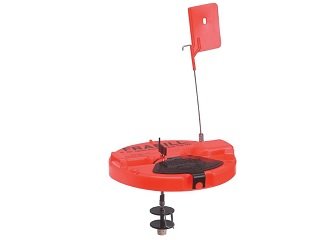 Ice fishing can be a little intimidating if you’ve never tried it before, especially if you set your sights on big numbers and lay tip-ups on the ice. In Part One, I shared some tip-up advice that will especially help those who’ve never used them. Today, we’ll keep the train rolling with more tip-up tips.
Ice fishing can be a little intimidating if you’ve never tried it before, especially if you set your sights on big numbers and lay tip-ups on the ice. In Part One, I shared some tip-up advice that will especially help those who’ve never used them. Today, we’ll keep the train rolling with more tip-up tips.
One major mistake that many ice anglers make—seasoned or otherwise—is fishing in too small of a vertical area. Often times they’ll simply miss their targeted depth by as little as half a foot or so, and wind up missing the fish completely. Be sure to use your electronics, if you have them, to pinpoint where in the water column fish are feeding. For example, in late winter you may find that fish are higher than usual, closer to the ice, looking for water with more oxygen.
Be sure to check on your tip-ups now and then to make sure they’re not frozen, there’s still bait on the line, and your line hasn’t become tangled in weeds. During colder times of the day, like later on at night, check to make sure your holes haven’t frozen over. The Frabill Thermal, a tip-up that fits over the entire hole, will go a long way towards ensuring this doesn’t happen.
It can be harrowing to keep an eye on your tip-ups from a fixed location, so it’s smart to arrange them in a line, or at least around the same area. This way, you can simply glance in one direction to see if any flags are tripped. Furthermore, if there’s deep snow or if the visibility is poor—either due to blizzard conditions or darkness—try a longer flag arm or a light that you can attach to the flag.
If you think you’ve got a fish on your tip-up line, it’s important to get a solid hookset when the time comes. This is why smaller hooks are a great idea. Their smaller size won’t stick out so much in the fish’s mouth and make them less apt to spit out the bait. When the fish runs, wait to feel its weight, then set it hard.
I know I’ve thrown a lot of tips at you in this series, but tip-ups can be frustrating to work with if you’ve never spent time with them before. Furthermore, knowing how to work them is only half the battle; you have to know how to use them on the ice. Spending








